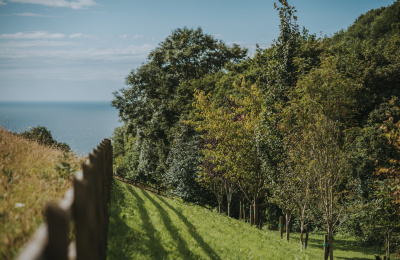Like bats and butterflies, birds are one of the key wildlife groups considered to be excellent indicators of environmental health and habitat quality.
Monitoring birds can tell us about changes in their environment which we may not be able to detect. Over time, the monitoring can be valuable for informing habitat management. Along with the bats and butterflies, birds are an essential part of our ongoing wildlife monitoring programme.
How do we survey birds?
We carry out winter bird surveys (January and February) to count overwintering species and a breeding bird survey (March to August) to record species and their activities. Defending territories, nest building, feeding young, the arrival of summer migrants, and the departure of winter migrants are all things we monitor.
We survey set transects (routes) once a month, counting and identifying the species we encounter as we walk and noting behaviour such as singing, nest building and carrying food. The transects cover many habitats, including donkey paddocks, haylage fields, scrub, woodland and woodland edge, and hedgerows, which offer food and shelter to birds (and donkeys!).
The surveys in 2019 and 2020
In 2019 we carried out our initial baseline bird surveys across our farms. In 2020 we carried out our first year of monitoring. While we had a successful winter bird survey, Covid-19 restrictions meant that sadly we had to miss the start of the breeding season and resume surveys in June and not survey all transects.
However, we still recorded more than 50 different species of birds across the farms. Many of the species we recorded are categorised by the RSPB as 'Red List' species, meaning that they need urgent action and are of great conservation concern. These included fieldfares, grey wagtails, house sparrows, linnets, marsh tits, mistle thrush, redwings, skylarks, song thrush, starlings, woodcocks and yellowhammers.
In addition to these, staff and visitors spotted or heard species outside of the surveys, including tawny owls, snipe, wheatears, peregrine falcons, dippers, cirl buntings and kestrels, to name but a few.
Overall, sightings in 2020 were similar to 2019, with both years recording around 2000 sightings for January, February, June, and July. The top eight most recorded birds in 2019 were the same for 2020 except that in 2019 goldfinches reigned supreme, but they were knocked off the top of the pecking order by the house sparrows this year. The habitats at the farms offer good resources for these species since they favour hedgerows, scattered trees and bushes, rough ground with thistles and other seeding-bearing plants. Robins, blue tits, wrens and blackbirds also fared well and again, their favoured hedgerow and woodland habitats are widely available at the sanctuary.
Whereas in 2019, the grass was regularly mown short, in 2020, many birds were 'flushed' out of grass that had grown tall, and we frequently saw them feeding on the seedheads of plants that would not usually reach maturity. They were likely finding many more invertebrates hiding within the long grass too.




